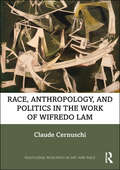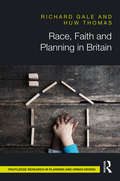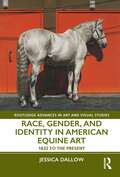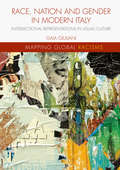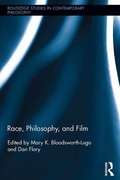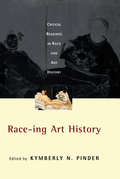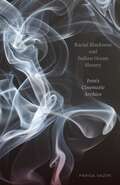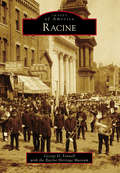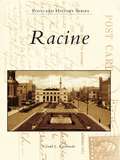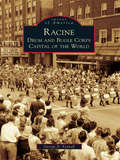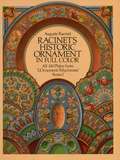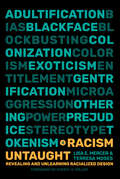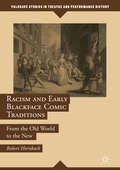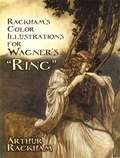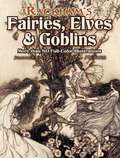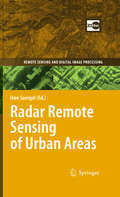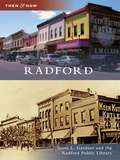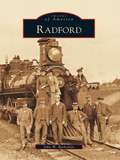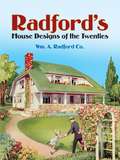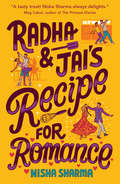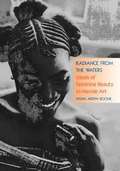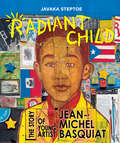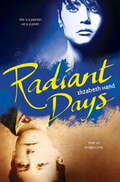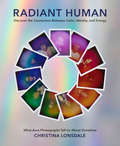- Table View
- List View
Race under Reconstruction in German Cinema
by Angelica FennerRace Under Reconstruction in German Cinema investigates postwar racial formations via a pivotal West German film by one of the most popular and prolific directors of the era. The release of Robert Stemmle's Toxi (1952) coincided with the enrolment in West German schools of the first five hundred Afro-German children fathered by African-American occupation soldiers. The didactic plot traces the ideological conflicts that arise among members of a patrician family when they encounter an Afro-German child seeking adoption, herein broaching issues of integration at a time when the American civil rights movement was gaining momentum and encountering violent resistance.Perceptions of 'Blackness' in Toxi demonstrate continuities with those prevailing in Wilhelmine Germany, but also signal the influence of American social science discourse and tropes originating in icons of American popular culture, such as Uncle Tom's Cabin, Birth of a Nation, and several Shirley Temple films. By applying a Cultural Studies approach to individual film sequences, publicity photos, and press reviews, Angelica Fenner relates West German discourses around race and integration to emerging economic and political anxieties, class antagonism, and the reinstatement of conventional gender roles.The film Toxi is now available on DVD from the DEFA Film Library.
Race, Anthropology, and Politics in the Work of Wifredo Lam (Routledge Research in Art and Race)
by Claude CernuschiThis book reinterprets Wifredo Lam’s work with particular attention to its political implications, focusing on how these implications emerge from the artist’s critical engagement with 20th-century anthropology. Field work conducted in Cuba, including the witnessing of actual Afro-Cuban religious ritual ceremonies and information collected from informants, enhances the interpretive background against which we can construe the meanings of Lam's art. In the process, Claude Cernuschi argues that Lam hoped to fashion a new hybrid style to foster pride and dignity in the Afro-Cuban community, as well as counteract the acute racism of Cuban culture.
Race, Faith and Planning in Britain: the British experience in context
by Huw Thomas Richard GaleRace, Faith and Planning in Britain adopts a Critical Race Theory perspective to analyse and discuss challenges of planning in contemporary multi-ethnic Britain. Exploring how planning is affected by and affects the racialisation of social relations, this book charts the history of the UK planning system’s approach, in terms of the spatial consequences of immigration, and discourses of diversity, cohesion, citizenship and belonging. Authors Richard Gale and Huw Thomas pay special attention to the experiences of minority groups in Britain, including Gypsies and Travellers, and British Muslims. They underline that the struggle over planning in racialised societies must be construed as part of a wider political struggle over equality. This book is an essential read for students and practitioners of planning in multi-cultural contexts.
Race, Gender, and Identity in American Equine Art: 1832 to the Present (Routledge Advances in Art and Visual Studies)
by Jessica DallowThis book traces an evolution of equine and equestrian art in the United States over the last two centuries to counter conventional understandings of subjects that are deeply enmeshed in the traditions of elite English and European culture. In focusing on the construction of identity in painting and photography—of Blacks, women, and the animals themselves involved in horseracing, rodeo, and horse show competition—it illuminates the strategic and varying roles visual artists have played in producing cultural understandings of human-animal relationships. As the first book to offer a history of American equine and equestrian imagery, it shrinks the chasm of literature on the subject and illustrates the significance of the genre to the history of American art. This book further connects American equine and equestrian art to historical, theoretical, and philosophical analyses of animals and attests to how the horse endures as a vital, meaningful subject within the art world as well as culture at large. This book will be of interest to scholars in art history, American art, gender studies, race and ethnic studies, and animal studies.
Race, Nation and Gender in Modern Italy: Intersectional Representations In Visual Culture (Mapping Global Racisms)
by Gaia GiulianiThis book explores intersectional constructions of race and whiteness in modern and contemporary Italy. It contributes to transnational and interdisciplinary reflections on these issues through an analysis of political debates and social practices, focusing in particular on visual materials from the unification of Italy (1861) to the present day. Giuliani draws attention to rearticulations of the transnationally constructed Italian ‘colonial archive’ in Italian racialised identity-politics and cultural racisms across processes of nation building, emigration, colonial expansion, and the construction of the first post-fascist Italian society. The author considers the ‘figures of race’ peopling the Italian colonial archive as composing past and present ideas and representations of (white) Italianness and racialised/gendered Otherness. Students and scholars across a range of disciplines, including Italian studies, political philosophy, sociology, history, visual and cultural studies, race and whiteness studies and gender studies, will find this book of interest.
Race, Philosophy, and Film (Routledge Studies in Contemporary Philosophy #50)
by Mary K. Bloodsworth-Lugo Dan FloryThis collection fills a gap in the current literature in philosophy and film by focusing on the question: How would thinking in philosophy and film be transformed if race were formally incorporated moved from its margins to the center? The collection’s contributors anchor their discussions of race through considerations of specific films and television series, which serve as illustrative examples from which the essays’ theorizations are drawn. Inclusive and current in its selection of films and genres, the collection incorporates dramas, comedies, horror, and science fiction films (among other genres) into its discussions, as well as recent and popular titles of interest, such as Twilight, Avatar, Machete, True Blood, and The Matrix and The Help. The essays compel readers to think more deeply about the films they have seen and their experiences of these narratives.
Race-ing Art History: Critical Readings in Race and Art History
by Kymberly N. PinderRace-ing Art History is the first comprehensive anthology to place issues of racial representation squarely on the canvas. Art produced by non-Europeans has naturally been compared to Western art and its study, which refers to a binary way of viewing both. Each essay in this collection is a response to this vision, to the distant mirror of looking at the other.
Racial Blackness and Indian Ocean Slavery: Iran's Cinematic Archive
by Parisa VaziriRethinking the history of African enslavement in the western Indian Ocean through the lens of Iranian cinema From the East African and Red Sea coasts to the Persian Gulf ports of Bushihr, Kish, and Hurmuz, sailing and caravan networks supplied Iran and the surrounding regions with African slave labor from antiquity to the nineteenth century. This book reveals how Iranian cinema preserves the legacy of this vast and yet long-overlooked history that has come to be known as Indian Ocean slavery. How does a focus on blackness complicate traditional understandings of history and culture? Parisa Vaziri addresses this question by looking at residues of the Indian Ocean slave trade in Iranian films from the second half of the twentieth century. Revealing the politicized clash between commercial cinema (fīlmfārsī) and alternative filmmaking (the Iranian New Wave), she pays particular attention to the healing ritual zār, which is both an African slave descendent practice and a constitutive element of Iranian culture, as well as to cinematic sīyāh bāzī (Persian black play). Moving beyond other studies on Indian Ocean and trans-Saharan slavery, Vaziri highlights the crystallization of a singular mode of historicity within these cinematic examples—one of &“absence&” that reflects the relative dearth of archival information on the facts surrounding Indian Ocean slavery. Bringing together cinema studies, Middle East studies, Black studies, and postcolonial theory, Racial Blackness and Indian Ocean Slavery explores African enslavement in the Indian Ocean through the revelatory and little-known history of Iranian cinema. It shows that Iranian film reveals a resistance to facticity representative of the history of African enslavement in the Indian Ocean and preserves the legacy of African slavery&’s longue durée in ways that resist its overpowering erasure in the popular and historical imagination. Retail e-book files for this title are screen-reader friendly with images accompanied by short alt text and/or extended descriptions.
Racine
by George D. Fennell Racine Heritage MuseumWhen Gilbert Knapp founded Racine in 1834 and the first pioneers settled there, no one had the remotest idea that the wilderness would one day transform into a thriving city. Ideally situated on Lake Michigan at the mouth of the Root River, the site was chosen by Knapp because of its harbor potential. The prospect of farming on the level prairies surrounding Racine also attracted many of the area's first settlers. Racine County is especially suited for growing wheat, which immediately became the county's leading agricultural product. The town of Racine quickly became a prosperous center serving the needs of the area's farm population. Even Racine's industrial base was founded on wheat; in 1842, J.I. Case invented a wheat thresher that helped Racine to grow into one of the foremost industrial centers in the United States.
Racine (Postcard History)
by Gerald L. KarwowskiIn November 1834, Capt. Gilbert Knapp staked a claim to 141 acres at the mouth of the Root River, naming it Port Gilbert. This site became the city of Racine. During the pioneer years, Racine was dubbed "the Belle City" of the Great Lakes (from the French word belle, meaning "beautiful"). The growth of this beautiful city and its harbor was captured in vintage postcards at a time when people sent little notes and messages to friends and family theway people use e-mail and cell phones today. These cards are like vignettes showing the changes that have taken place since one century ago--a pictorialdocumentation of Racine preserved for future generations to enjoy.
Racine: Drum and Bugle Corps Capital of the World
by George D. FennellMany activities become short-lived fads. Not so for the drum and bugle corps in Racine. Here, after 150 years, drum and bugle corps activity still flourishes as a proud tradition. Racine is the self-proclaimed drum corps capital of the world. Racine had six competing drum and bugle corps during the 1960s and 1970s--very impressive for a community of 90,000. In fact, it would be difficult to find a longtime resident who is unaware of this activity. Everyone in Racine either was a member of or had family or friends who were members of a drum and bugle corps.
Racinet's Historic Ornament in Full Color (Dover Fine Art, History of Art)
by Auguste Racinet2,000 decorative motifs expertly reprinted in full color from a rare 19th-century publication. Adapted from borders, tiles, carved wood panels, and other ornamental sources, the designs include classic Egyptian, Greek, Roman and Etruscan motifs; Chinese, Japanese, Persian and Indian patterns; samples from the Arabic and Byzantine cultures; Celtic, medieval, Renaissance and 18th century European art.
Racism Untaught: Revealing and Unlearning Racialized Design
by Lisa E. Mercer Terresa MosesA powerful and proven guidebook that shows organizations how to recognize racism in designed artifacts, systems, and experiences—and how to replace them with anti-racist design solutions.Anti-racist design interventions can be difficult. Well-intentioned conversations can fuel tensions, activate racialized trauma, and lead to misunderstandings, especially in spaces not typically focused on diversity, equity, and inclusion. Even when progress is made, white supremacy culture can resurface. We need anti-racist guidelines and approaches that lay bare racialized systems of oppression and fundamentally disrupt their replication. In Racism Untaught, Lisa E. Mercer and Terresa Moses, two veteran anti-racist educators, deliver this exact approach.Mercer and Moses provide a step-by-step guide to anti-racist interventions in academic, business, and community settings that benefits all participants. Adapted from their successful workshop series and filled with concrete examples and ample case studies, their book teaches participants how to analyze design—and reimagine racialized artifacts, systems, and experiences guided by anti-oppressive principles. They demonstrate how to examine positionality within the context of racism and oppression; help us understand how design can reinforce and perpetuate oppression; and reveal the unique relationship among equity, ethics, and responsibility that constitutes the core value of an anti-racist design discipline. In Racism Untaught, Mercer and Moses provide the framework we need to unlearn racialized design practices and move more generatively toward collective liberation.With a foreword by renowned designer Cheryl D. Miller, Racism Untaught is a valuable tool for anyone who wants to help themselves and their organization create an actionable and inclusive plan to dismantle racial oppression and instead realize equitable, anti-racist, and liberatory design.
Racism and Early Blackface Comic Traditions: From the Old World to the New (Palgrave Studies in Theatre and Performance History)
by Robert HornbackThis book traces blackface types from ancient masks of grinning Africans and phallus-bearing Roman fools through to comedic medieval devils, the pan-European black-masked Titivillus and Harlequin, and racial impersonation via stereotypical 'black speech' explored in the Renaissance by Lope de Vega and Shakespeare. Jim Crow and antebellum minstrelsy recycled Old World blackface stereotypes of irrationality, ignorance, pride, and immorality. Drawing upon biblical interpretations and philosophy, comic types from moral allegory originated supposedly modern racial stereotypes. Early blackface traditions thus spread damning race-belief that black people were less rational, hence less moral and less human. Such notions furthered the global Renaissance’s intertwined Atlantic slave and sugar trades and early nationalist movements. The latter featured overlapping definitions of race and nation, as well as of purity of blood, language, and religion in opposition to 'Strangers'. Ultimately, Old World beliefs still animate supposed 'biological racism' and so-called 'white nationalism' in the age of Trump.
Rackham's Color Illustrations for Wagner's "Ring"
by Arthur Rackham James SperoBy the time he created these images, Rackham was England's leading illustrator, famous throughout the world for his interpretations of fairy tales and myths. These illustrations from the original 1911 and 1912 editions, widely regarded as the greatest representations of Wagner's drama, constitute Rackham's masterworks. 64 full-page color images and 9 vignettes.
Rackham's Fairies, Elves and Goblins: More than 80 Full-Color Illustrations
by Jeff A. MengesThrough his extraordinarily drawn interpretations of favorite fairy tales and fantastic literature, Arthur Rackham (1867-1939) remains an enduring legend of the Victorian era's Golden Age of Illustration. Rackham took the printing developments of the early twentieth century further than any other artist of his time, masterfully manipulating the latest color processes. At once a technical and artistic genius, Rackham had few equals when it came to the use of muted color, ambience, and expressive lines. This magnificent collection displays more than eighty of Arthur Rackham's most beguiling illustrations. These phantasmagoric renderings spring from such literary legends as Rip Van Winkle, A Midsummer Night's Dream, Alice's Adventures in Wonderland, Aesop's Fables, Puck of Pook's Hill, Peter Pan in Kensington Gardens, and A Wonder Book. From the loveliest fairy to the most grotesque goblin, Rackham's art captures the wonder, innocence, and adventure that forever stir the human heart.
Radar Remote Sensing of Urban Areas
by Uwe SoergelThis book presents a unique collection of state-of-the-art contributions by international remote sensing experts focussing on methodologies to extract information about urban areas from Synthetic Aperture Radar (SAR) data. SAR is an active remote sensing technique capable to gather data independently from sun light and weather conditions. Emphasizing technical and geometrical issues the potential and limits of SAR are addressed in focussed case studies, for example, the detection of buildings and roads, traffic monitoring, surface deformation monitoring, and urban change. These studies can be sorted into two groups: the mapping of the current urban state and the monitoring of change. The former covers, for instance, methodologies for the detection and reconstruction of individual buildings and road networks; the latter, for example, surface deformation monitoring and urban change. This includes also investigations related to the benefit of SAR Interferometry, which is useful to determine either digital elevation models and surface deformation or the radial velocity of objects (e.g. cars), and the Polarization of the signal that comprises valuable information about the type of soil and object geometry. Furthermore, the features of modern satellite and airborne sensor devices which provide high-spatial resolution of the urban scene are discussed.
Radford
by Radford Public Library Scott L. GardnerSituated on the New River, Radford has served as a gateway since its earliest days. Pioneers journeyed westward through the area along the Wilderness Road in the 1700s and 1800s, and the railroad made its way west in the 1850s, bringing about a boom in development. Today Radford still welcomes people with its small-city living, natural beauty, and educational opportunities. Author Scott L. Gardner, director of Glencoe Museum, has partnered with the Radford Public Library, where he has worked for over five years.
Radford (Images of America)
by John W. BarksdaleRadford, Virginia, is a city with a remarkable history. Native Americans settled the area long before Europeans moved into the region in the mid-18th century. The Virginia and Tennessee Railroad created a line in 1854 that linked Lynchburg with Bristol. Central Depot, which later became Radford, was a midway point on that rail line. Radford was established as a city in 1892, and two Virginia governors, James H. Tyler and John N. Dalton, have claimed Radford as their home. Radford Normal School, an institute for teacher training, was established in 1913 and has grown to become Radford University. Glencoe Museum, the Radford Heritage Foundation, and the citizens of Radford have all contributed to this collection of photographs. Images of America: Radford is a tribute to the rich and interesting stories of the city's past.
Radford's House Designs of the Twenties
by Wm. A. Radford Co.Created as an aid to architects, carpenters, and builders, this Radford Architectural Company of Chicago catalog was also welcomed by future home owners. Included are such houses as the Bixby, a two-bedroom bungalow, the Coventry, a charming Dutch Colonial with three bedrooms and other accommodations, and more. 189 black-and-white illustrations.
Radha & Jai's Recipe for Romance
by Nisha SharmaTo All the Boys I Loved Before meets World of Dance in this delectable love story that combines food, dance, and a hint of drama to cook up the perfect romance.Radha is on the verge of becoming one of the greatest kathak dancers in the world . . . until a family betrayal costs her the biggest competition of her life. Now she has left her Chicago home behind to follow her stage mom to New Jersey. At the Princeton Academy of the Arts, Radha is determined to leave performing in her past and reinvent herself from scratch.Jai is captain of the Bollywood Beats dance team, ranked first in his class, and is an overachiever with no college plans. Tight family funds means medical school is a pipe dream, which is why he wants to make the most out of high school. When Radha enters his life, he realizes she's the exact ingredient he needs for a show-stopping senior year.With careful choreography, both Radha and Jai will need to face their fears (and their families) if they want a taste of a happily ever after."A delicious YA rom-com full of heart, flavor, and just enough heat." --JULIE MURPHY, New York Times bestselling author of Dumplin'"A tasty treat! Nisha Sharma always delights." --MEG CABOT, author of The Princess Diaries"A sumptuous tale of dance, food, and culture. I savored every last page!" --PINTIP DUNN, New York Times bestselling author
Radiance from the Waters: Ideals of Feminine Beauty in Mende Art
by Sylvia Ardyn BooneThe Sande Society of the Mende people of Sierra Leone is a secret female regulatory society that both guards and transmits the ideals of feminine beauty so fundamental to the aesthetic criteria in Mende culture. In this eloquent and moving book, Sylvia Ardyn Boone describes the Society, its rituals and organization, and the mask worn by its members. Her book is an evocative account of Mende life and philosophy as well as a unique contribution to the study of African art, one based on African conceptions about the person and the human body.
Radiant Child: The Story of Young Artist Jean-Michel Basquiat
by Javaka SteptoeA visually stunning picture book biography about modern art phenomenon Jean-Michel Basquiat, written and illustrated by Coretta Scott King Award winner Javaka Steptoe.<P><P> Jean-Michael Basquiat and his unique, collage-style paintings rocketed to fame in the 1980s as a cultural phenomenon unlike anything the art world had ever seen. But before that, he was a little boy who saw art everywhere: in poetry books and museums, in games and in the words that we speak, and in the pulsing energy of New York City. Now, award-winning illustrator Javaka Steptoe's vivid text and bold artwork echoing Basquiat's own introduce young readers to the powerful message that art doesn't always have to be neat or clean--and definitely not inside the lines--to be beautiful.<P> Winner of the Caldecott Medal
Radiant Days
by Elizabeth HandShe is a painter. He is a poet. Their art bridges time. It is 1978. Merle is in her first year at the Corcoran School of Art, catapulted from her impoverished Appalachian upbringing into a sophisticated, dissipated art scene. It is also 1870. The teenage poet Arthur Rimbaud is on the verge of breaking through to the images and voice that will make his name. The meshed power of words and art thins the boundaries between the present and the past - and allows these two troubled, brilliant artists to enter each other's worlds. Radiant Days is a peerless follow- up to Elizabeth Hand's unforgettable, multiply starred Illyria.
Radiant Human: Discover the Connection Between Color, Identity, and Energy
by Christina LonsdaleA revolutionary exploration of the relationship between human energy and color, visualized through more than 200 photographs from the “the Annie Leibovitz of aura photography” (New York Times) and a “Dutch painter on acid” (Vogue).The prodigal daughter of a visionary painter mother and a two-time commune founding father, Christina Lonsdale was raised by her parents on a commune in Taos, New Mexico, at the dawn of the digital age in the 1990s—formative years when science (the advent of the worldwide web, the introduction of the cell phone) and spiritualism (New Age) occupied equal bandwidth. Having her aura photograph taken awoke a passion that combined her spiritual and technological interests (an aura is an energy field emanating around a living being comprised of mental, spiritual, and emotional levels; an aura camera captures the colors of the aura on Polaroid film). With her first aura camera—the Auracam 6000—she began photographing and analyzing family and friends, then in 2014, took her skills and equipment on the road.Radiant Human includes hundreds of Polaroids selected from the author’s vast archives of some 45,000 images she has taken over a six-year period. The book explores the nature of the human aura, and the notion that aura images may not only capture a person’s essence in that moment, but reveal characteristics of their overall disposition. As Lonsdale describes what all the colors suggest, considering their many variations and nuances, and in relationship to each other. To illuminate her discoveries, she shares her subjects’ stories throughout the book, sometimes accompanied by a single shot, other times by a series of images taken over a period of year. She also includes profiles of well-known people she has photographed including Chloë Sevigny, Joseph Altuzarra, Busy Philipps, and SZA. Lonsdale makes clear that we are not just physical bodies, but collections of energy as well—giving consideration to the relationship of how we present ourselves to the world and who we are as well as the potential reality of the space in between. Her aura work is a study of humanity, and the energy we radiate and receive—the good, the bad, and the weird vibes—helping us understand better who we are.

